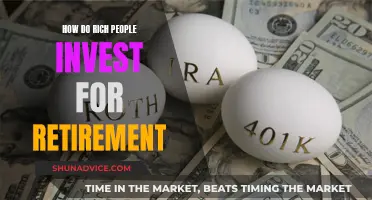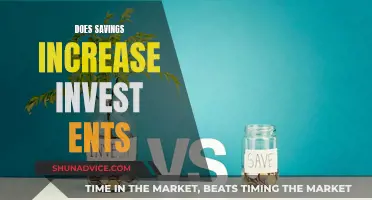
Silver has been used as a store of wealth for 5,000 years and is viewed as a safe-haven asset. Silver is also a good investment option during times of economic uncertainty and high inflation. It is also a good option for those looking to preserve their wealth in difficult times. Silver is a tangible asset and is cheaper and more flexible than gold, making it a more accessible investment option. Silver is also a valuable asset as it has always been a dependable investment with intrinsic value that has never waned over the centuries. However, silver is a more volatile investment option compared to gold. Silver is also vulnerable to theft, and its demand leads to higher premiums.
| Characteristics | Values |
|---|---|
| Safe-haven asset | Silver is a safe-haven asset, protecting investors in times of turmoil and economic uncertainty. |
| Finite tangible asset | Silver is a finite tangible asset, with a limited and diminishing supply. |
| Store of value | Silver has been used as a store of value for 5,000 years. |
| Inflation hedge | Silver can protect against inflation, as its value is not dependent on the value of fiat currencies. |
| Geopolitical hedge | Silver can protect against geopolitical risks, such as war, terrorism, and political crises. |
| Industrial demand | Silver has many industrial uses, including in solar panels, electric vehicles, medical equipment, and electronics. |
| Volatility | Silver is more volatile than gold, making it a more speculative investment. |
| Affordability | Silver is more affordable than gold, making it more accessible to investors. |
| Diversification | Silver can be used to diversify a portfolio and reduce risk. |
What You'll Learn

Silver as a safe haven and a hedge against inflation
Silver has been used as a store of wealth for 5,000 years. In ancient Rome, the gold-silver ratio was fixed at 12:1, meaning it took 12 ounces of silver to buy one ounce of gold. Silver has been used for jewellery and precious objects for as long as it has been a store of value.
Silver is often viewed as a safe haven and a hedge against inflation. When the returns on traditional investments such as stocks and shares decline, investors may look to swap a proportion of their capital into assets (such as precious metals) that may hold their value or even increase as other investments' returns fall. Silver prices may also struggle or fall when the economic outlook darkens, because its strong industrial uses mean productive demand may drop if a recession hits.
Silver has anti-microbial and non-toxic properties, which is why some of its earliest uses were in the storage of fresh foods and liquids. In the 21st century, NASA astronauts drink water purified by ionized silver rather than using chlorine, the traditional substance. Silver is also a vital component in making solar panels, as it has the highest electrical and thermal conductivity of any metal.
Silver is often referred to as "poor man's gold", and it has many of the same attributes as its more expensive cousin. Silver is a more affordable option for investors looking to diversify their portfolio. It can be bought physically with bars and coins or with intangible options such as silver mining stocks and silver ETFs.
Silver prices tend to rise with inflation. During times of inflation, the value of fiat currencies tends to decline, while the value of precious metals may increase. Silver is a tangible asset, and its value is derived from its scarcity and its uses in the industrial and electronic sectors.
Silver's availability, plus its unique properties as a precious metal, underpins its many industrial, medical and technological uses. This sets silver apart from gold as an asset to invest in, by making it an indispensable metal for the modern age.
The Retail Apocalypse: Amazon's Dominance and the Threat to REITs
You may want to see also

Silver's correlation with gold
Silver is often viewed as having a parallel investment case to gold, and it frequently follows gold higher on futures markets. Gold and silver prices tend to move together, and since 1968, the two metals have had a very close correlation value of 0.63 (1.0 being a perfect correlation). However, silver prices are more volatile. For every 1% move in gold, silver moves 3% on average.
The gold-silver ratio is the oldest continuously tracked exchange rate in history. It describes the price relationship between the two metals, indicating how many ounces of silver it takes to equal the value of one ounce of gold. On 26 July 2024, the ratio was about 85:1.
The gold-silver ratio used to be set by governments for monetary stability, but now it fluctuates with the market. The Roman Empire officially set the ratio at 12:1. In medieval Europe, it fell to 9.4:1 in 1350 but climbed back to 12:1 in the 1450s. The US government fixed the ratio at 15:1 with the Coinage Act of 1792.
The discovery of massive deposits of silver in the Americas, combined with attempts by several governments to manipulate gold and silver prices, led to greater volatility in the 20th century. The ratio has ranged mainly between 50:1 and 70:1 in the 21st century, breaking above that point in 2018 with a peak of 104.98:1 in 2020. The lowest level for the ratio was 35:1 in 2011.
Gold is primarily used as real money, while silver's primary value stems from its use in industry. Silver's unique properties as a precious metal underpin its many industrial, medical, and technological uses, including solar panels, electronics, and water purification.
Silver is considered an inflation hedge like gold, but its primary value driver is its industrial use. Silver is also viewed as a safe-haven asset, a store of value, and a way to hedge against declines in purchasing power.
SPACs: The New Investment Craze
You may want to see also

Silver's affordability and accessibility
Silver is often referred to as "poor man's gold" due to its lower price point in comparison to gold. It is a more accessible option for investors, particularly those who are unable to invest large sums. Silver's affordability and accessibility are key benefits that make it an attractive investment option.
The price of silver is influenced by various factors, including global supply and demand, market conditions, and geopolitical events. As of November 2023, the silver spot price, which is the current price at which raw silver can be bought and sold for immediate delivery, was $24.07 per ounce. This price is constantly fluctuating and investors need to stay informed about market conditions and performance indicators to make strategic decisions.
One of the advantages of investing in silver is its affordability. Gold is generally more expensive and inaccessible for some investors, making silver a more budget-friendly option. Silver also has a lower entry point, allowing a broader range of investors to include it in their portfolios. This accessibility is particularly beneficial for those who cannot afford gold but want to diversify their investment portfolios.
For those who prefer a more hands-off approach, there are intangible options such as silver mining stocks, ETFs, and futures and options. Silver mining stocks allow investors to benefit from the silver market without owning the physical metal. ETFs, or Exchange-Traded Funds, track the price of silver and can be traded like stocks on major exchanges, offering ease of trading and eliminating storage concerns. Silver futures and options provide more complex investment opportunities, with the potential for substantial returns for knowledgeable investors.
In conclusion, silver's affordability and accessibility make it a compelling investment option. Its lower price point compared to gold, diverse investment options, and sensitivity to market demand and economic conditions contribute to its accessibility and attractiveness as an investment choice.
The Name Game: Unveiling Invest 98's True Identity
You may want to see also

Silver's volatility and risk
Silver is a volatile investment option. Its price is driven by speculation and supply and demand, like most commodities. However, silver is more volatile than gold due to its smaller market, lower market liquidity, and demand fluctuations between industrial and store-of-value uses. The silver market is considerably smaller than the gold market, which can exacerbate volatility.
The volatility of silver prices is also influenced by its correlation with gold prices. Gold and silver prices tend to move together, and the gold/silver ratio is often analyzed by traders, investors, and buyers. The ratio can vary, but for every 1% move in gold prices, silver prices move by 3% on average. This makes silver a riskier investment option compared to gold.
Silver's volatility can be further attributed to its industrial uses. Silver has many industrial, medical, and technological applications, including its use in solar panels, electronics, and water purification. As a result, silver prices can be influenced by economic cycles and fluctuations in industrial demand.
When investing in silver, it is essential to consider the various risks associated with it. One risk is that silver does not produce cash flow, so it may not be clear when it is a good time to buy. Additionally, the price of silver can be influenced by speculation and supply and demand, which can lead to wide-ranging valuations in the market.
Another risk to consider is the storage and insurance costs associated with physical silver. If you choose to invest in physical silver, you will need to safeguard it and possibly insure it, which can add to the overall cost of the investment.
Overall, silver is a volatile investment option with various risks that potential investors should carefully consider before making any decisions.
Investing: Why the Fear?
You may want to see also

Silver's industrial uses
Silver is an essential component in many industries due to its unique properties, such as its high electrical and thermal conductivity, malleability, ductility, and antibacterial qualities. Here are some of its key industrial uses:
Electronics and Electrical Components
Silver is widely used in electronics and electrical components because of its high electrical conductivity. It is found in electrical switches, circuit boards, connectors, and capacitors. Silver is also used in the production of electrical contacts, such as those in printed circuit boards and membrane switches, because of its high electrical conductivity and durability. Its use in these components ensures that electrical current can pass through when the contacts are joined.
Solar Panels and Photovoltaic Cells
Silver is an integral part of solar panels and photovoltaic cells, which are used to generate solar energy. Silver is used as a conductive ink or paste in the production of these cells, which transform sunlight into electricity. Its reflective qualities also make it useful in the generation of solar power. The use of silver in this industry is expected to grow, with the photovoltaic sector demanding around 100 million ounces of silver annually.
Brazing and Soldering
Silver is commonly used in brazing and soldering, which are processes that join two metal pieces together. Silver brazing and soldering create tight, leak-proof, and corrosion-resistant joints between metal parts. Silver is particularly useful in these processes because of its high tensile strength and ductility. It is often used in joining copper pipes that carry water or air, as well as in air conditioning, refrigeration, and electric power distribution.
Medicine and Healthcare
Silver has long been valued in medicine for its antibacterial and antimicrobial properties. It is used in wound dressings, surgical instruments, and ointments to prevent infections and promote healing. Silver ions interfere with bacterial cell membranes and metabolic processes, making silver an effective weapon against a wide range of harmful bacteria. Silver is also used in medical equipment, water purification systems, and even textiles to inhibit the growth of bacteria and other microorganisms.
Mirrors and Reflective Coatings
Silver's high reflectivity makes it a crucial component in the manufacturing of mirrors. A thin layer of silver is deposited onto a glass surface to create a reflective coating. These silver industrial coatings are used not only in mirrors but also in optics, solar panels, and automotive mirrors. They enhance the reflective properties of these products and contribute to the production of high-quality mirrors.
Chemical Production
Silver also acts as a catalyst in chemical production, aiding in the production of important chemicals such as ethylene oxide and formaldehyde. These chemicals are used in the manufacturing of plastics, resins, and protective coatings. Silver increases the speed of reactions without being consumed in the process, making it an essential component in chemical production.
Condo Investment in Panama City: A Guide to Buying Smart
You may want to see also
Frequently asked questions
Silver can often be a smart investment, but it's not right for everyone. Silver is a good investment if you are seeking long-term growth, are comfortable with some risk and volatility, or want to diversify your portfolio.
One of the biggest silver investment disadvantages is its volatility. While that can often mean big growth, it can also mean significant loss if you need to sell at the wrong time. Silver also doesn't provide interest or dividends, so it's not suitable if you're seeking a steady income stream.
Silver is a precious metal with endless real-life uses, so there is potential for growth. It is also a large component in electric vehicles, which have jumped in production and popularity in recent years. Silver is also generally seen as a safe investment and can help to diversify your portfolio.







